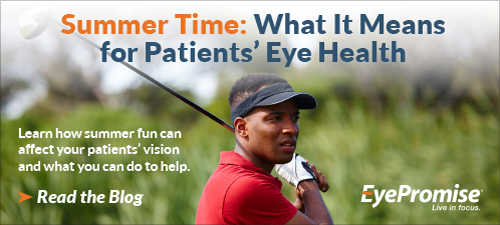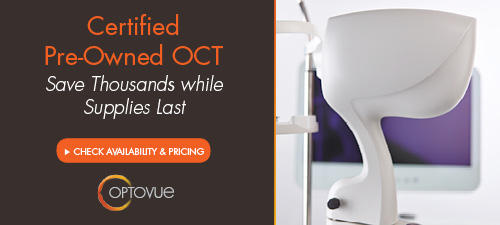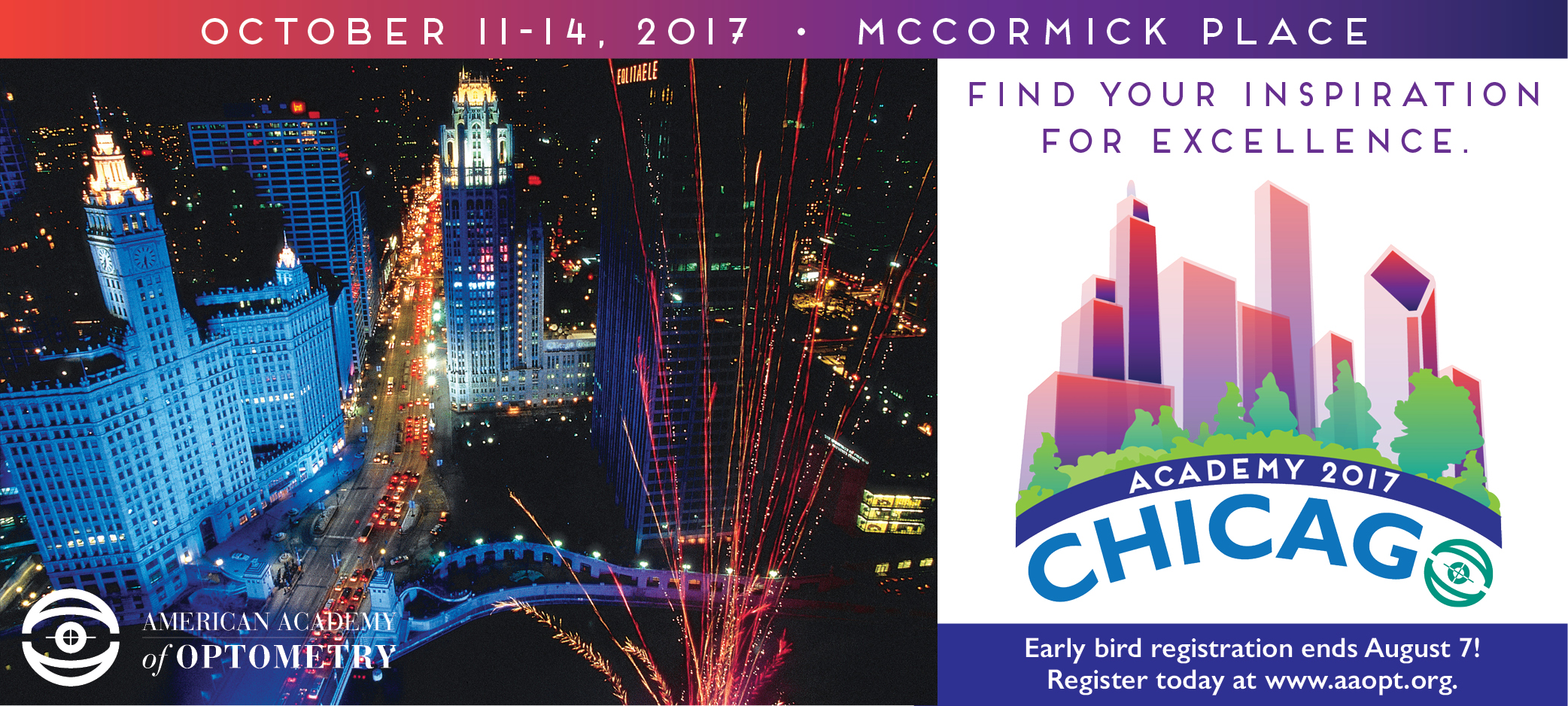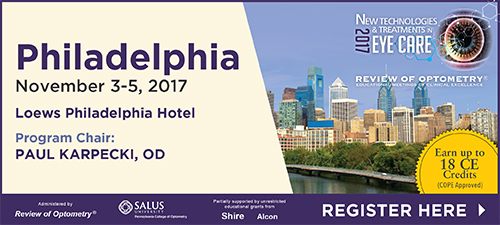
A
weekly e-journal by Art Epstein, OD, FAAO
Off the Cuff: Vision Tests…At What Cost?
I have been giving a lot of thought to the proliferation of online and smartphone vision testing. The Smart Vision Labs (“doctor-on-a-stick”) five-minute eye exam particularly fascinates me. The company is clever, very aggressive, and its story is convincing enough to sway some otherwise sensible people. Unlike Opternative, its technology is comparable to an autorefractor, but as I see it, this exam also represents a significant public health menace when utilized without direct professional supervision.
|
|||||
 |
||
| Impact of Age At First Childbirth on Primary Open-angle Glaucoma | ||||
Researchers wrote that no studies until now have addressed the relationship between the timing of first childbirth and primary open-angle glaucoma (POAG). The aim of this study was to identify the relationship between age at first childbirth and POAG, and to examine the contribution of parity to the age at first childbirth and POAG relationship in postmenopausal women. The study population comprised postmenopausal women ages 50 or above in the cross-sectional Korea National Health and Nutrition Examination Survey from 2010 to 2012. Participants were grouped into quintiles by age at first childbirth for analysis. This study used logistic regression and mediation analyses with accommodations for the complex sampling structure of the survey.
Of the 4,057 women in the study population, the mean age at first childbirth was 23.7 years, and POAG prevalence was 3.4%. Prevalence of POAG was lowest in women whose first childbirth was between the ages of 27 and 44 (1.8%). Their risk for POAG (odds ratio [OR], 0.25; 95% CI, 0.10-0.65) was significantly lower than risk in women whose first childbirth was between the ages of 13 and 20 after adjustments for covariates. Late first delivery (≥27 y) was directly (OR, 0.57) and totally (OR, 0.85) associated with the decreased risk of POAG; decreased parity in women who delivered their first child at an older age attenuated the age at first childbirth and POAG relationship (OR of indirect effect, 1.50). First childbirth at the age of 27 years or above decreased the risk of POAG in postmenopausal women. Decreased parity, caused by late first childbirth, attenuated the magnitude of the total effects of age at first childbirth on POAG. |
||||
SOURCE: Park S, Choi NK. Impact of age at first childbirth on primary open-angle glaucoma. Menopause. 2017; Jul 10. [Epub ahead of print]. |
||||
 |
||
| Neonatal Retinoblastoma | ||||
From 7% to 10% of all retinoblastomas, and from 44% to 71% of familial retinoblastomas in developed countries are diagnosed in the neonatal period, usually through pre- or postnatal screening prompted by a positive family history and sometimes serendipitously during screening for retinopathy of prematurity or other reasons. In developing countries, neonatal diagnosis of retinoblastoma has been less common. Neonatal retinoblastoma generally develops from a germline mutation of RB1, the retinoblastoma gene, even when the family history is negative and is, thus, usually hereditary.
At least one-half of infants with neonatal retinoblastoma have unilateral tumors when the diagnosis is made, typically the International Intraocular Retinoblastoma Classification (Murphree) Group B or higher. However, most germline mutation carriers will progress to bilateral involvement, typically Group A, in the fellow eye. Neonatal leukokoria usually leads to the diagnosis in children without a family history of retinoblastoma, and a Group C tumor or higher is typical in the more advanced involved eye. Almost all infants with neonatal retinoblastoma have at least one eye with a tumor in proximity to the foveola, but the macula of the fellow eye is frequently spared. Consequently, loss of reading vision from both eyes is exceptional. A primary ectopic intracranial neuroblastic tumor, known as trilateral retinoblastoma, is no more common after the neonatal phase than other types of retinoblastoma. For many reasons, neonatal retinoblastoma may be a challenge to eradicate, and the early age at diagnosis and relatively small tumors do not guarantee the preservation of both eyes of every involved child. Oncology nurses can be instrumental in contributing to better outcomes by ensuring that hereditary retinoblastoma survivors receive genetic counseling, by referring families of survivors to early screening programs when they are planning for a baby, and by providing psychological and practical support for parents when neonatal retinoblastoma has been diagnosed. |
||||
SOURCE: Kivelä TT, Hadjistilianou T. Neonatal retinoblastoma. Asia Pac J Oncol Nurs. 2017;4(3):197-204. |
||||
 |
||
| Comparison of the Retinal Microvascular Density Between Open-angle Glaucoma and Nonarteritic Anterior Ischemic Optic Neuropathy | ||||
This study compared optical coherence tomography angiography (OCTA) retinal vasculature measurements between nonarteritic anterior ischemic optic neuropathy (NAION) and open-angle glaucoma (OAG) with altitudinal hemifield visual field defects. This retrospective cross-sectional study included 10 NAION eyes and 16 OAG eyes—both demonstrating hemifield visual field defects—and 27 normal eyes serving as controls. The peripapillary and macular OCTA scans were acquired, and retinal vessel density data were compared among NAION, glaucomatous and control eyes.
There were statistically significant differences in peripapillary whole image vessel density (wiVD), circumpapillary VD (cpVD), macular wiVD and perifoveal VD (pfVD) between the three groups. In comparisons between OAG and NAION groups, the NAION group demonstrated marked decreases in average cpVD and in most cpVD sectors except for the inferior one; the OAG group demonstrated significant decreased macular wiVD and pfVD. Multivariate analysis indicated that the average thickness of retinal nerve fiber layers was the only predictor for peripapillary wiVD and cpVD. By contrast, thickness of ganglion cell complex was the only predictor for macular wiVD. OCTA detected significant differences in peripapillary and macular retinal vessel densities between OAG and NAION eyes. Researchers concluded that these differences might provide comparative insight into the pathophysiology of these two diseases. |
||||
SOURCE: Liu CH, Wu WC, Sun MH, et al. Comparison of the retinal microvascular density between open angle glaucoma and nonarteritic anterior ischemic optic neuropathy. Invest Ophthalmol Vis Sci. 2017;58(9):3350-6. |
||||
|
|||
| News & Notes | |||||||||
| Sun Appoints Dr. Mitchell Sun Ophthalmics recently appointed of Brittany Mitchell, OD, as associate director of professional relations. Following graduation from the University of Alabama at Birmingham School of Optometry in 2012, Dr. Mitchell spent five years in clinical practice at Alabama Vision Center, where she managed all postoperative cataract and corneal transplant patients. Her experience as a speaker for Bausch + Lomb included multiple vision care brand launches in the United States and Canada, and she recently served as a speaker for Shire Ophthalmics.
|
|||||||||
Inotek FDC Trial of Trabodenoson Shows No Clinical Advantage At Day 56
|
|||||||||
| FDA Rejects Ocular Therapeutix Resubmission of Dextenza NDA In a Complete Response Letter to Ocular Therapeutix regarding its resubmission of a New Drug Application for Dextenza (dexamethasone insert) 0.4mg for the treatment of ocular pain following ophthalmic surgery, the U.S. Food and Drug Administration stated it could not approve the NDA in its present form. The CRL referred to deficiencies in manufacturing processes and analytical testing related to the manufacture of drug products for commercial production identified during a pre-NDA approval inspection of the Ocular Therapeutix manufacturing facility completed in May 2017. Read more.
|
|||||||||
|
|||||||||
|
|||||||||
|
Optometric Physician™ (OP) newsletter is owned and published by Dr. Arthur Epstein. It is distributed by the Review Group, a Division of Jobson Medical Information LLC (JMI), 11 Campus Boulevard, Newtown Square, PA 19073. HOW TO ADVERTISE |







